What an amazing restyling of the website! Now is even more difficult to read than before, but I like the idea of green jungle Vietnam... btw...
Vietnam is rapidly catching up Thailand as tourists best destination in South East Asia. It is the cheapest country among its peers, with more than decent hostels at 2.5€ a night. I am here during the explosion of Coronavirus around the world, and Vietnam borders with China on the North: encouraging.
Differently than Thailand, the history of Vietnam is much more troubled and tormented. It was often occupied by the Chineese for thousands of years, before becoming a single state in the XIX century. But it lost its independence right after, falling entirely under France. The French invasion (1858-1954) was very humiliating for the Vietnamese, but it left a precious heritage in terms of architecture, infrastructure (railways and swamp reclaim... hanno fatto anche cose buone!!1!1!) and, most importantly, alphabet: in the Vietnamese language there are not idiograms but latin letters, so it may be an easier exotic leanguage to learn, if you are into exotic languages. The infamous Vietnam War (1955-1975) left a permanent scar in Vietnam population and its memory. 45 years after the American occupation (visiting this country is like taking part to a class of history), Vietnam is nowadays a vibrant and fast growing country with 90 million people rapidly improving their standard of life, and the future appears bright. It is a communist country, but does not sympathise very much with China. It has a very strong coffee culture being the second producer in the world after Brazil. Traffic is insane and fascinating at the same time. I start my journey from the South and climb up to the North.
HO CHI MINH CITY - SAIGON
Ho Chi Minh (1890-1969) was the communist leader who fought for the indipenence of Vietnam against the French occupation during the Indochina War (1946-1954), the Japanese occupation during the WWII and the Americans. He is the pragmatic, charismatic and patriottic father of the nation. Saigon was the capital of the South Vietnam, influenced by Americans during the war. In 1975 the communist entered the Government Palace (Reunification Palace) and won the war. Saigon was renamed "Ho Chi Minh City" in honor of his leader. Today HCMC has 7.4mln people, the most populated city of Vietnam. It is a fashinating mix of skyscrapers and French colonial architecture. It is a city that has a lot to offer, traffic included.
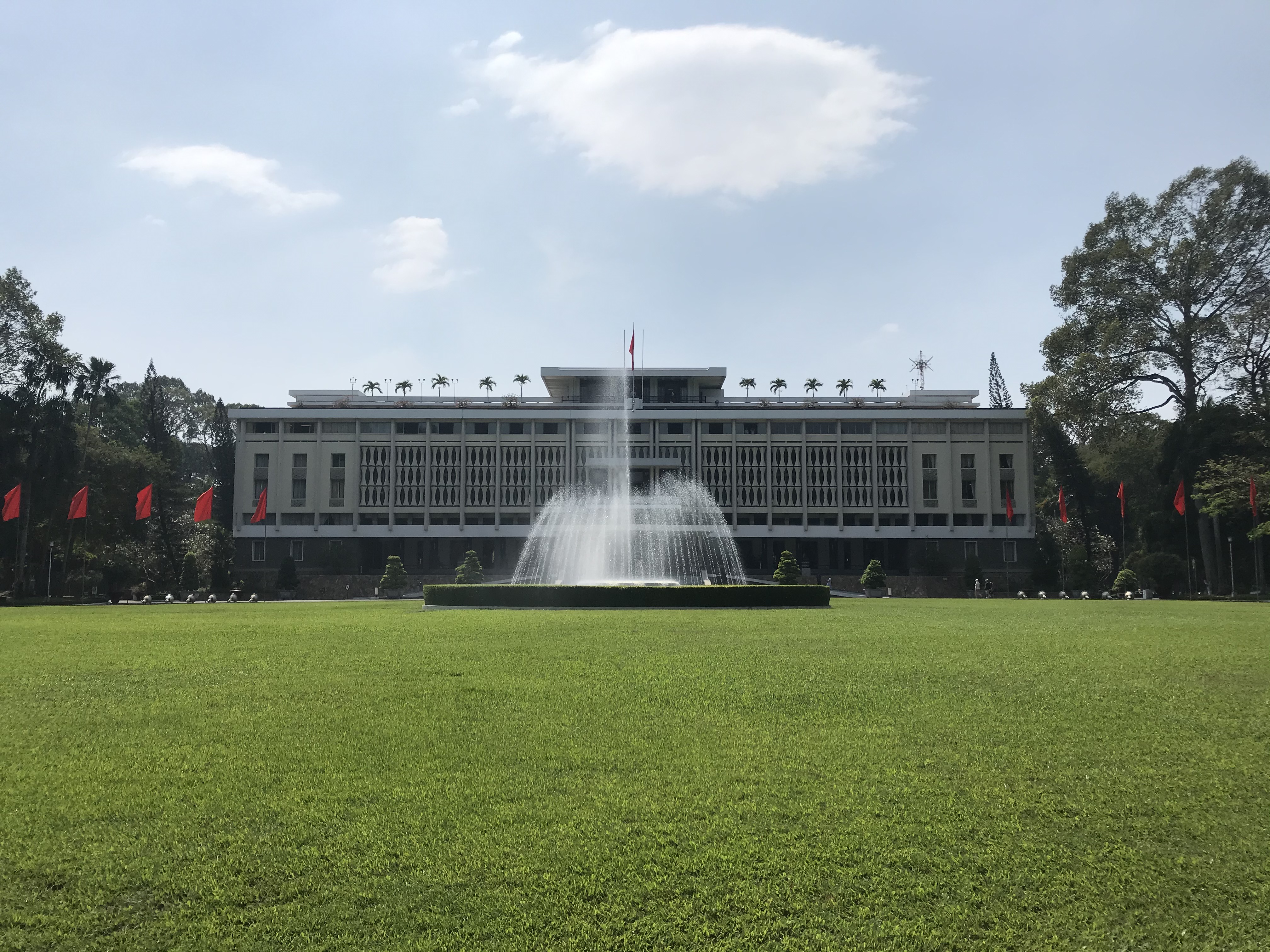

The citycenter of Saigon is very nice. There are a lot of colorful coffe shops, restaurants, smoothies bar, shiny glass skyscapers... It is very colorful and green, thanks to the tree-lined avenues running through the citycenter (a French heritage). This was my favourite place. It is a pedestrian street full of little book stores on both side. New or used, English or Vietnamese, old or recent, books or notebooks, you can find what you are looking for. There is a quiet and cozy athosphere so you can seat in the big open coffee shop reading or working on your laptop. At the end of the street, you find the most famous French architectures of the city: Notre-Dame de Paris Saigon, with two 40m square plant towers in the facade, and the Central Post Office, designed by Gustave Eiffel in 1886, which is both a touristic attraction and an actual Post Office.
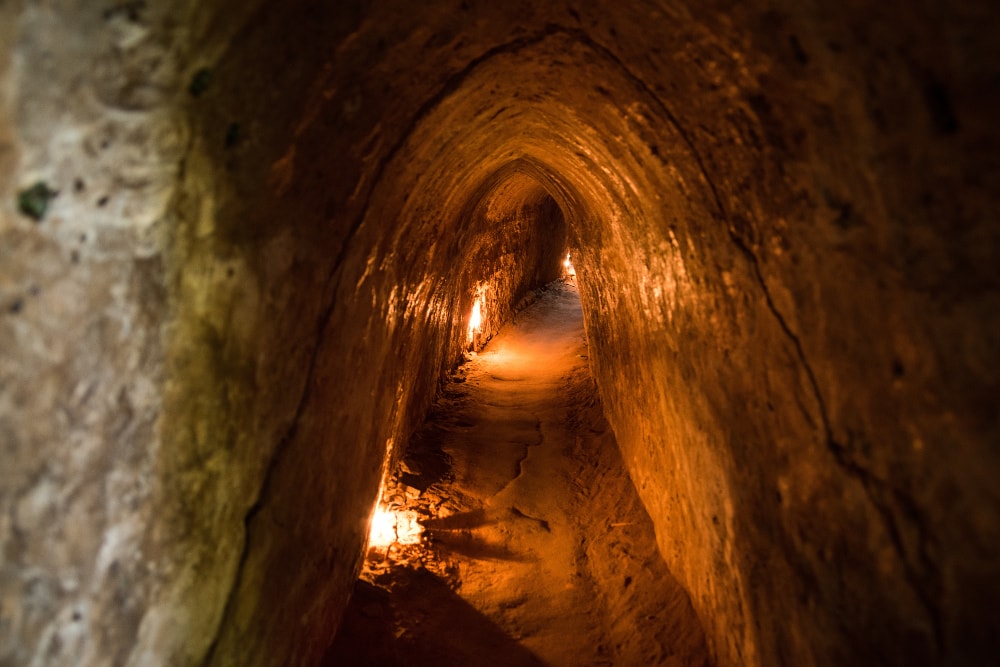
These were incredible. When you enemy is the most technologial advanced country in the world and you can rely only on bamboo sticks, you need to make do. Cu Chi Tunnels is a system of 250km of undergound tunnels at up to 20m depth outside Saigon, digged BY HAND or with basic tools. They were used to protect against massive bombing or napalm outside, and to organize sudden attaks in the night. VC were living here even for weeks. Complete darkness (candels burn oxigen, and artifical light was too expensive), narrow and low (VC were little guys, while for Americans was more difficult to access. Crawling inside was already difficult and painful for me that I just had a tshirt, imagine with the army uniform and weapons), no air (even though an incredible ventilation system was set up). Little clautrophoibic ah? There were even kitches, warehouses, curel Saw-style traps for who went inside without knowing the settings of the path. Wow.
The most typical thing in Saigon: traffic. There are no rules. The driving code is turned into fluid-dynamics laws: just go, stopping is even more dangerous than throw youself into the mob. You are a drop inside a river, so go with the flow. 7 million people, NO SUBWAY (they have no money for it), owning a car is prohibitive (imported cars are subjected to tariffs which turn the price 3x the actual cost). There are therefore around 7 million motorbikes invading the streets. There is an advantage though: the traffic never stops! Is very quick to move around. No traffic lights, you never end up bottled hours in traffic jam like in Bangkok. No space in the street? Just go on the sidewalk, no problem. Everyone is scared about buses, since the bigger has the precedence (they do not have problem to read-end and smash you on the asphalt). Reassuring.
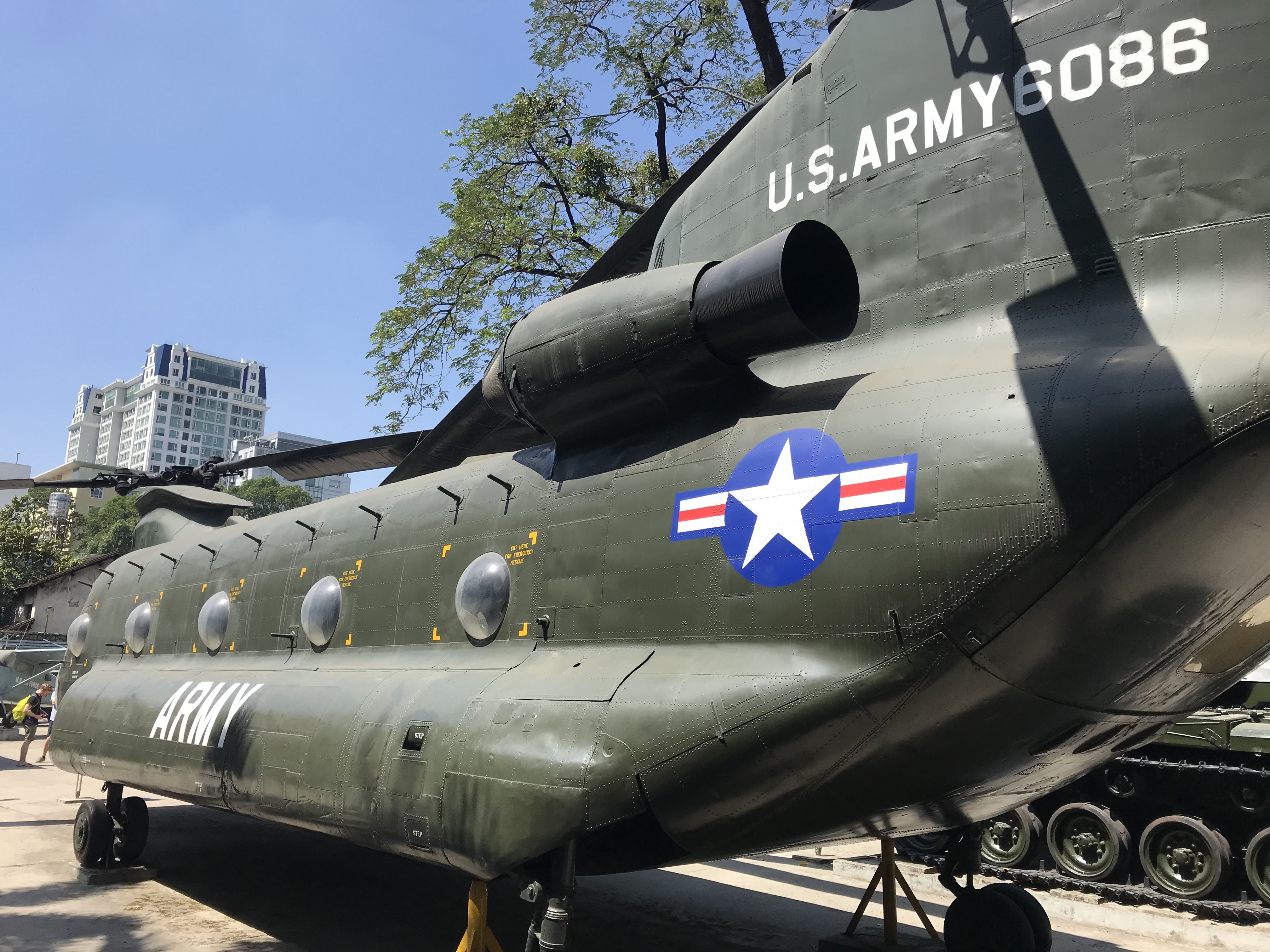
War Remnants Museum is the best museum of the city that wants to testify the brutality of war. It is interesting because it takes the point of view of Vietnam, even though America has always been quite transparent and honest in retrospect about its mistakes, so there were not big scoops. Robert McNamara, hawkish US Defence Secretary at that time, confessed "Yet we were wrong, terribly wrong. We owe it to future generations to explain why". Public opinion in America has always been terribly skeptical about this war (e.g. Hippy movement - 1969 Woodstock concert...). One of the most impressive cruelty was the use of Agent Orange, a chemical weapon used by Americans on 25% of Vietnamese territory for deforestation. Beside damaging the fertility of the turf for years, it created genetic problem among the population. Even the following generation of Vietnamese was directly affected by the war: many people were born with incredible phisical deformations. Deformed people who could not make anything in their miserable existance in a poor devastated country. But still, Vietnamese had the strenght to move on, without any resentment against US for what happened.
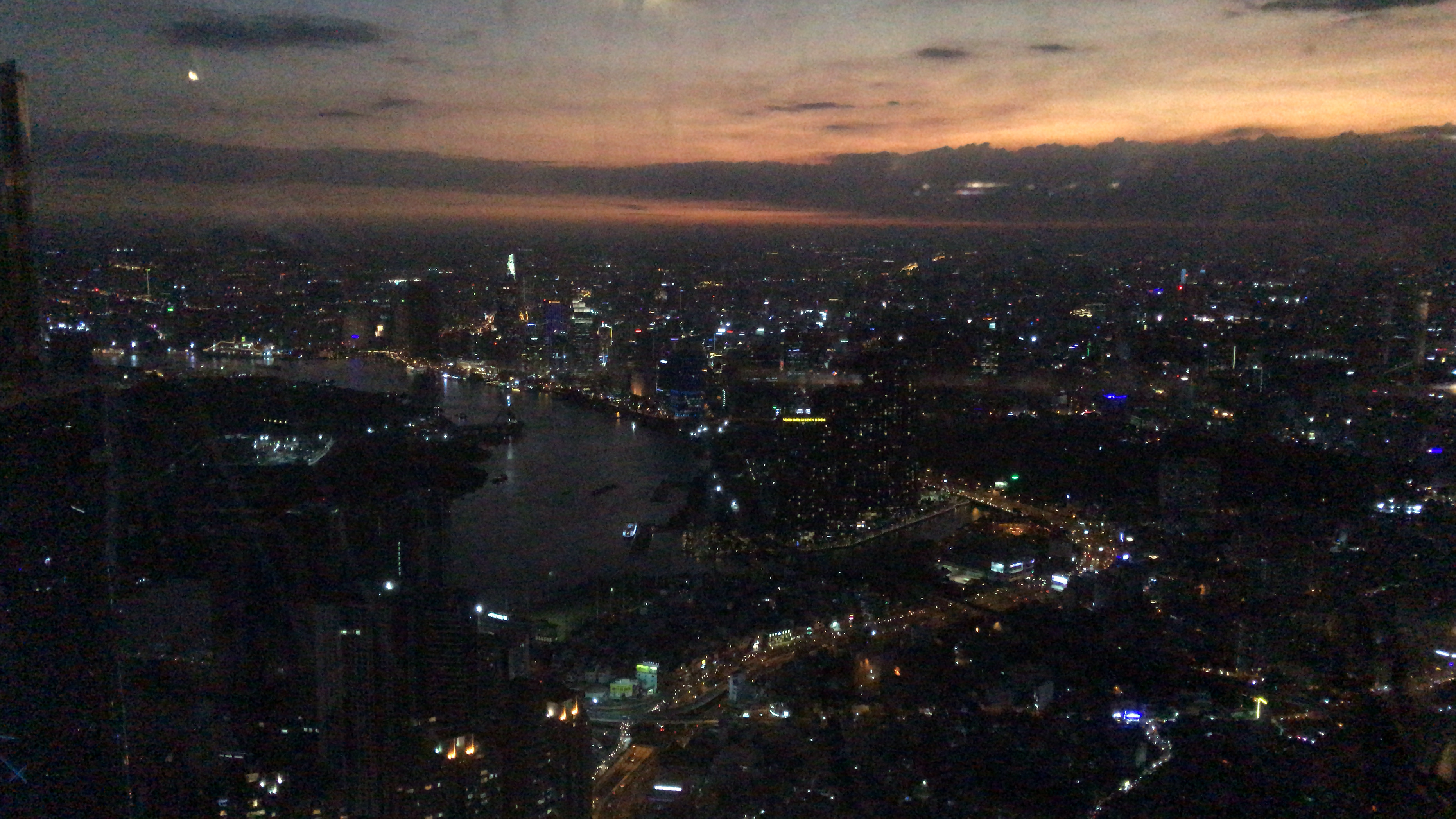
Come back to something more cheerful. This is the almost-top of the Landmark81, the tallest skyscrapers in South East Asia, and 17th tallest building in the world. I love skyscrapers, so I must go inside the tallest everytime I visit a country. Best tip: avoid the skydecks/terraces/obervatories. They are a very expensive way to go on the top of towers. Do instead a little of research and look for a lounge of a fancy hotel inside. You may sacrify a few floors, but the entrance is free. You just need to pay for a drink. Cheaper, same effect and you also have a drink to enjoy the panorama.
DALAT
Heading North, Dalat, 400k people, is one of the most popular touristic destination in VN. It is a city situated in a plateau 1500m above sea level, so it was used by the French, and still used nowadays, as a vacation site for escaping the humidity of the South tropical climate. French-style vaction villas are preserved since Dalat was fortunatelly spared by the Vietnam war. On the side of the steep and curvy streets characterizing a montane city, there are tons of bars, restaurants, neon lights, and beautiful hotels. But the best to see are the natural surroundings.

Rent a scooter for 5€ a day and stroll around the city. You will see many paddies (risaie), strawberry fields (forever), coffee and peppers plantations. Wine from Dalat is very famous in Vietnam. If you are hungry, stop in one of the villages around and eat in the houses of locals. I was expecting to eat something typical and local, but unfortunaly they had to offer just instant noodles. Life in the village is like our grandparents'. Little pretty kids catching innocent hens and nonchalantly tied them upside-down, put 'em in a platic bag, and sell 'em to pretty ganny. If you have empty cans or platic bottles, just throw them in the backyard. Here I realized that taking care of the environment is a mindset reserved for the "riches". People from the village of Vietnam couldn't care less about climate change, and this is understandable (like us at the end...).
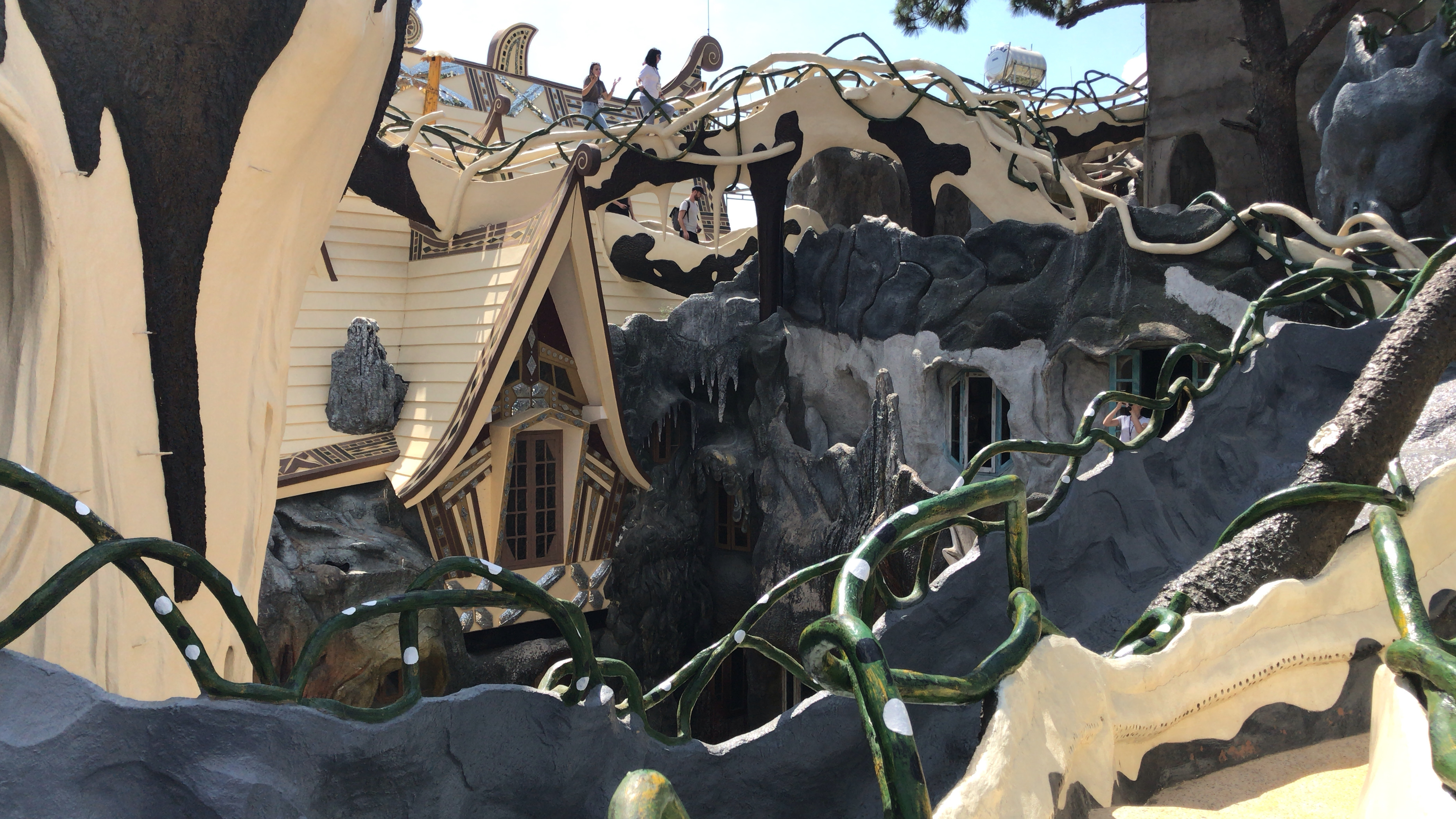
Hang Nga is the daughter of the president of Vietnam in the 1980s, who was the number two communist leader after HCM. So we are talking about VN élite. She graduated in architecture in Moscow. She built and owns this amazing house, the Crazy House. It reminds of course Gaudí houses in Barcelona. It is very big, there are stairs, ramps, terraces, narrow bridges, plants, trees twisting among each other. It is also a guesthouse, so you can rent very nice rooms for the night. If you manage to find them once you come back in the night, you can even sleep in them. It is like to be in a house from fairytales or from the Lord of Rings. It is one of the most extravagant things I ve ever seen until then, but, on the same day in the night, I saw something even more astonishing and disturbing: the Maze Bar.

This was insane. It is a bar in the center of Dalat built from the same architecture of the Crazy House. Same concept: a labirinth. Calling it "labirinth" is not an exageration. It is actually huge! More or less 5 floors (you do not really have specific "floors", since everything is tangled inside the external structure). While walking, you always find new alleys, doors, stairs, small ramps. Sometime is even dangerous because there are big holes on the pavement which heads you to the room below you. Same Tolkien athmosphere of the Crazy House, but in the dark. Get a drink and the entrance, and good luck! You can hear the music distantly from the rooftop where most people stay, but you often find yourself in dark and completely isolated corners, with creepy masks hanging out from the wooden walls. You may end up finding some drunk creatures who got lost in the bar months before when they were still a humans.
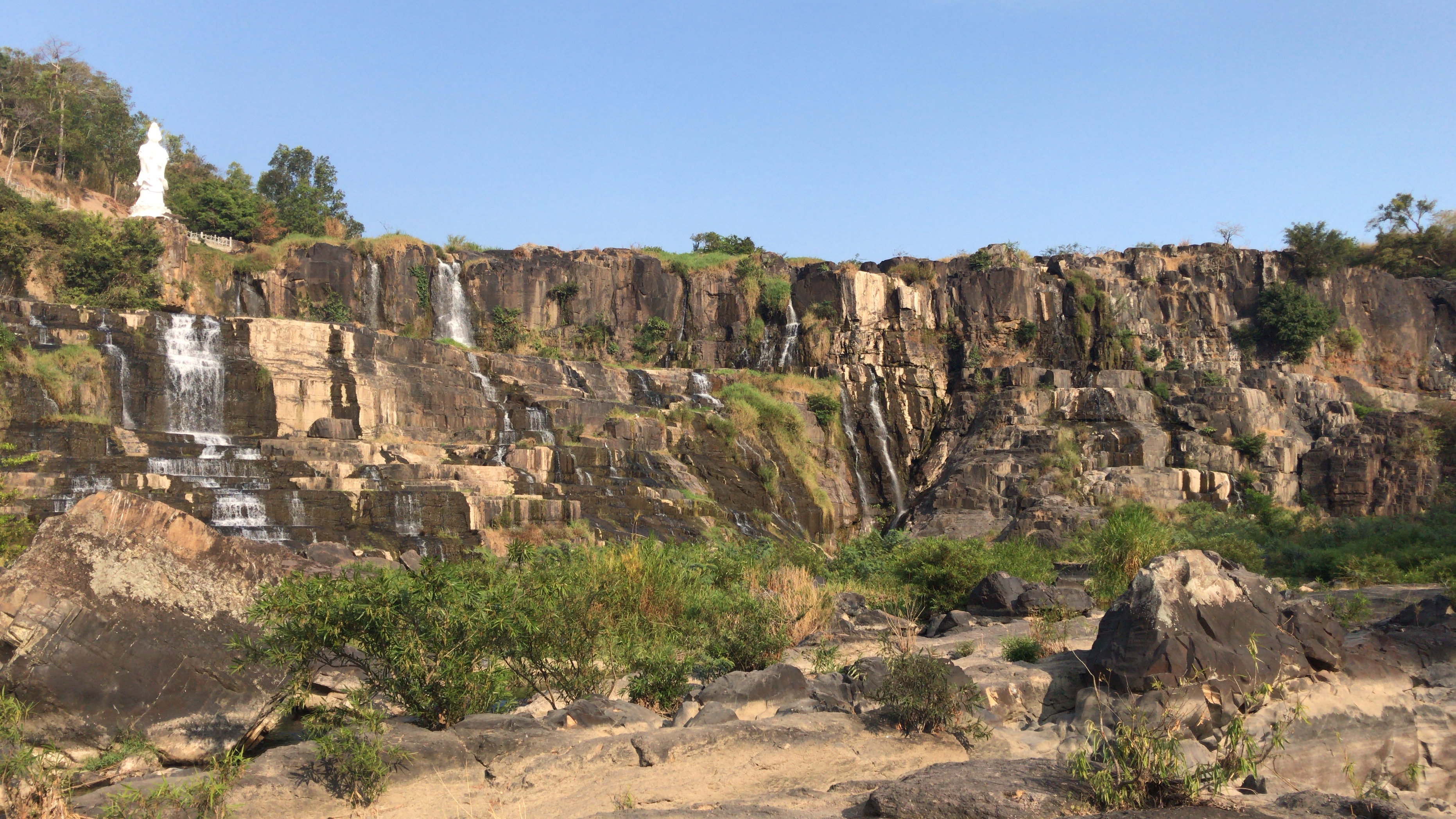
There are many waterfalls around the city. Pongour Falls are 2 hours by scooter from Dalat. They offer a better show during the rainy season when water is abundant. But they were still very nice. A group of nice Vietnamese invited me to their picnic there. They do not speak a word of English, but they are happy to meet Westerns to take selfies, offering beers and chicken feet.
HOI AN, DA NANG, HUÉ
Central Vietnam. There are 3 important cities one close to each other: Hoi An, Da Nang and Hué.
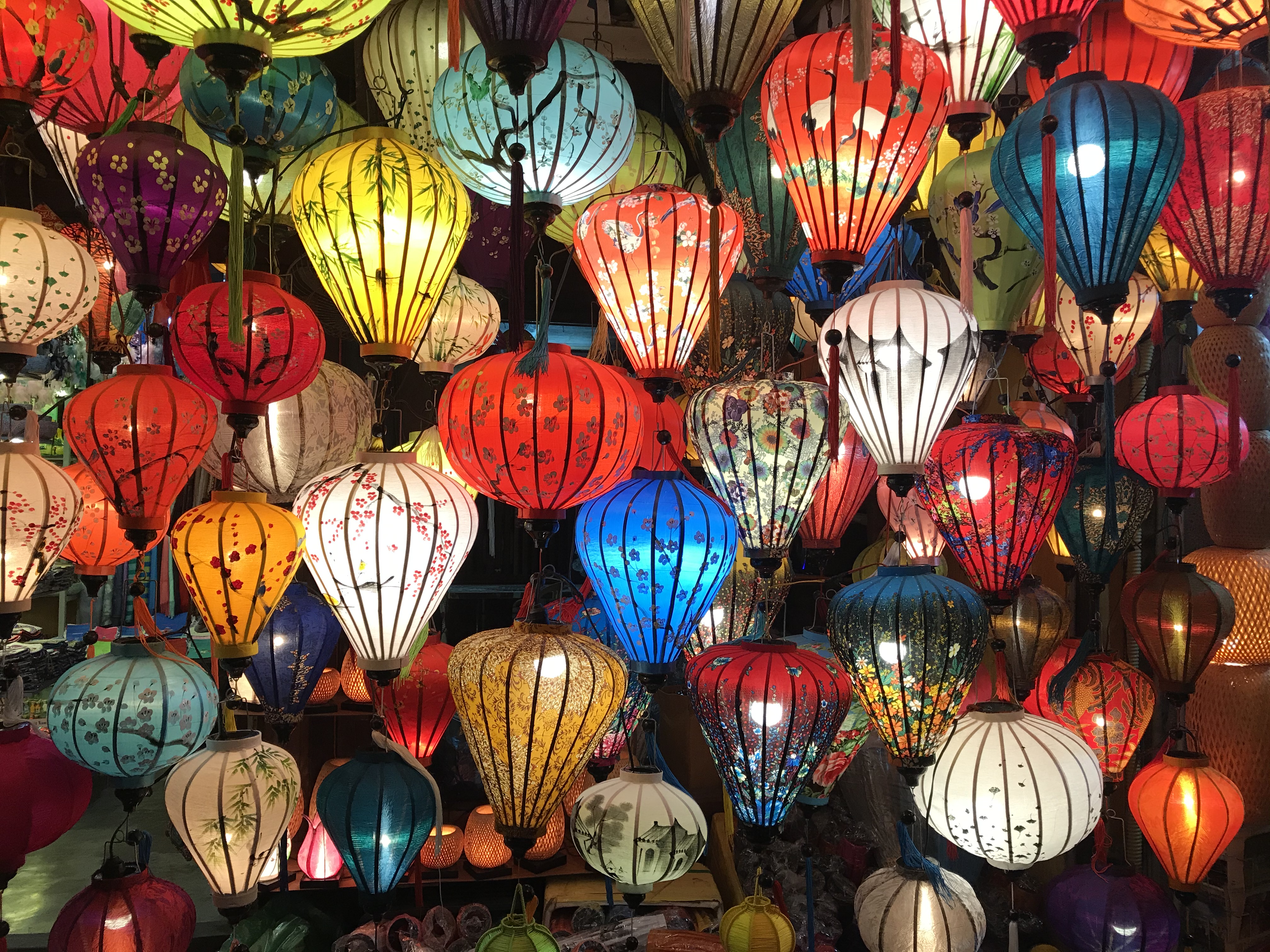
Hoi An is the most suggestive city I saw in my trip (see also the cover picture above). In the old town, you can walk through pedestrian streets surrounded by design souvenir shops, tons of little restaurants and craft-beer bars, with lit-up colorful lanterns hanging everywhere. A river crossing the citycenter contrubutes to the magical/romanitc atmosphere of Hoi An. It was the most imporant city-port of central Vietnam, and it was fortunately well preserved during wars. Many Chinese, Japanese and European rich merchants arrived in Hoi An for trading, building warehouses, bridges, customs and assembly halls for discussing about commerce. The old town of Hoi An was declared UNESCO World Heritage, and the ancient and international architectural patrimony you see nowadays is the same as it was in the past. 15 minutes by bike you find AnBang beach, facing the South China Sea and supposed to be one of the best beaches in VN: very nice, but nothing compared to Thailand.
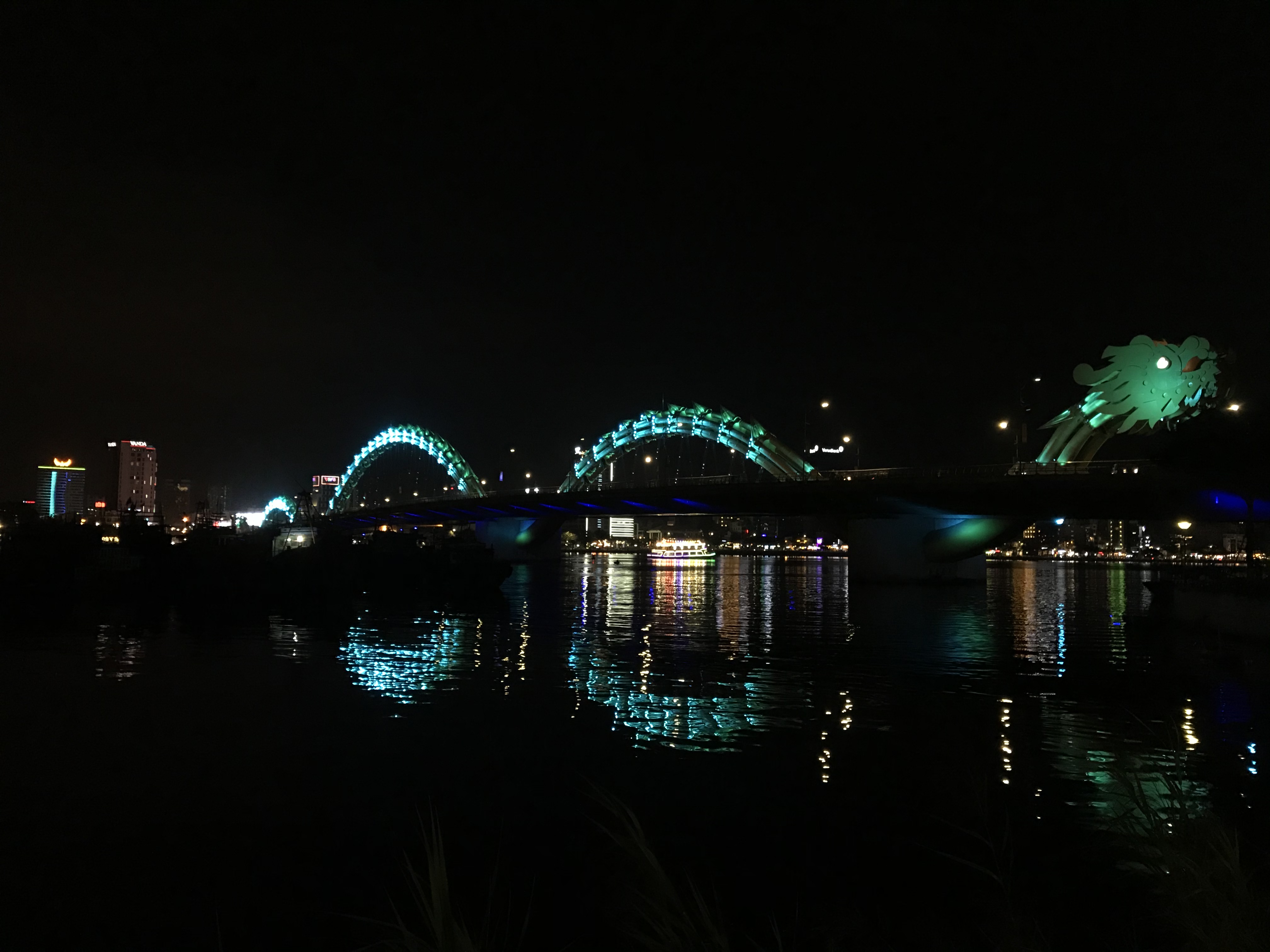
Da Nang is the biggest and dyniamic city in central Vietnam. Many luxury hotel and residential buildings are popping up around the city river at a very fast pace. It is dubbed "the Silicon Valley of Vietnam" thanks to the striving technological sector and companies in the city. The beach (I did not enjoy the beaches of central Vietnam because the weather was not good) is very close to the citycente. Da Nang Beach was the place where in 1965 the first american troops (3500 marines) disembarked in Vietnam. There is not so much to see in term of attractions, apart from the Dragoon Bridge in the picture, that breath fires and flames during weekend shows (I was there on a Tuesday). Not so touristic or particularly beautiful, but probably a more interesting city to live. You got the beach, you got the skyline mirrored on the river, you got a job in tech. What do you want more?
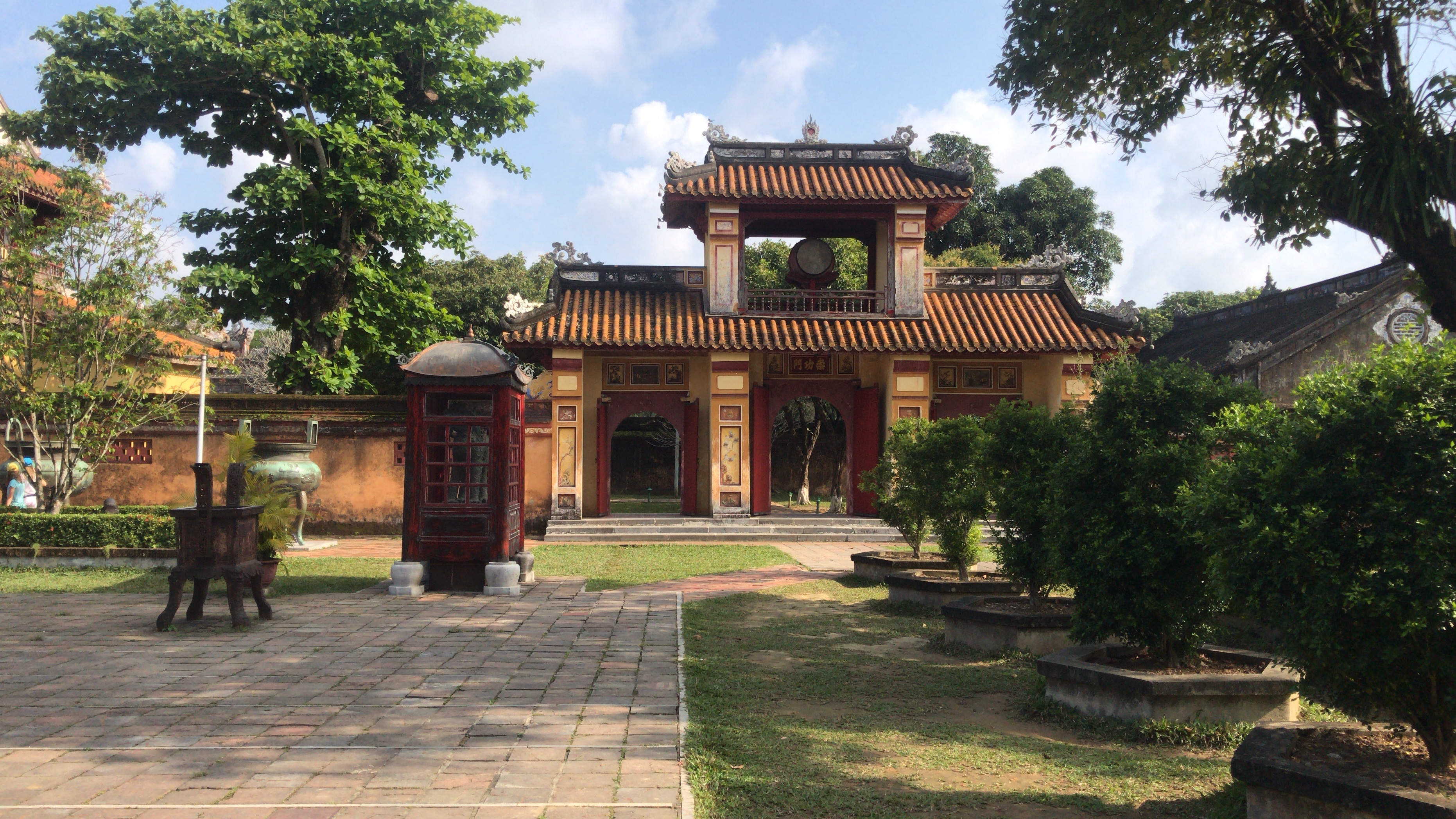
Hué was the capital of Vietnam on the XIX century, when the country was ruled by the emperors of the Nguyen dynasty, until the rise of communism in 1945. Similar story than China then. In Hué you can find the Imperial residence of the emperor, which is the equivalent of the Forbidden City in Beijing. Even here, the internal access was strictily reserved for women and eunuches. It is a little sad to visit the Imperial City: it was a marvelous compex of 148 builidngs comprising temples, palaces, governemtal buildings... After the wars against French and Americans only 20 are still standing, and also damaged. It is a little crumbling, but they are investing money to rebuild it step by step (even though, probably, the budget priority is the subway in Saigon). Note the red telephone box from London.
PHONG-NHA NATIONAL PARK
Another UNESCO World Heritage in Vietnam: Phong Nha National Park. Stunning landscape made up by blue rivers, fields and karstic mountains covered by thick tropical jungle. It is a famous destinaton for speleologist: in Phong-Nha you can find many caves systems, underground rivers and bats. Hang Son Doong is the biggest cave in the world, accidentally discovered in 2009 by a Vietnamese hunter. It is said that it could contain all New York City, just to give you an idea of the dimenstion. You can visit it only with a 3-4 day expedition, and it is quite extreame to explore, so you need to be a professional. Oh! The expedition costs 3000$... maybe another time.

As in Pai, and as all the nature-oriented travels, the best way to enjoy Phong-Nha is to rent a scooter (again, very easy. All the hostels have scooters parked outside, no driving licence needed, just pay and go, 4$ per day). The citycenter is just one main street with just hostels, very fancy karaoke malls, convenience stores, travel agencies and restuarants. Everything is extreamly cheap. I stayed in a zero-impact hostel where everything was made of wood for 2$ a night, in an amazing single room. There is not traffic, street are very wide, so it also safe to drive. So just go and enjoy the surrounding natural panorama, watch the cone-hat farmers working on the fields, visit villages where little kids say hello to every Western (and ask for money).
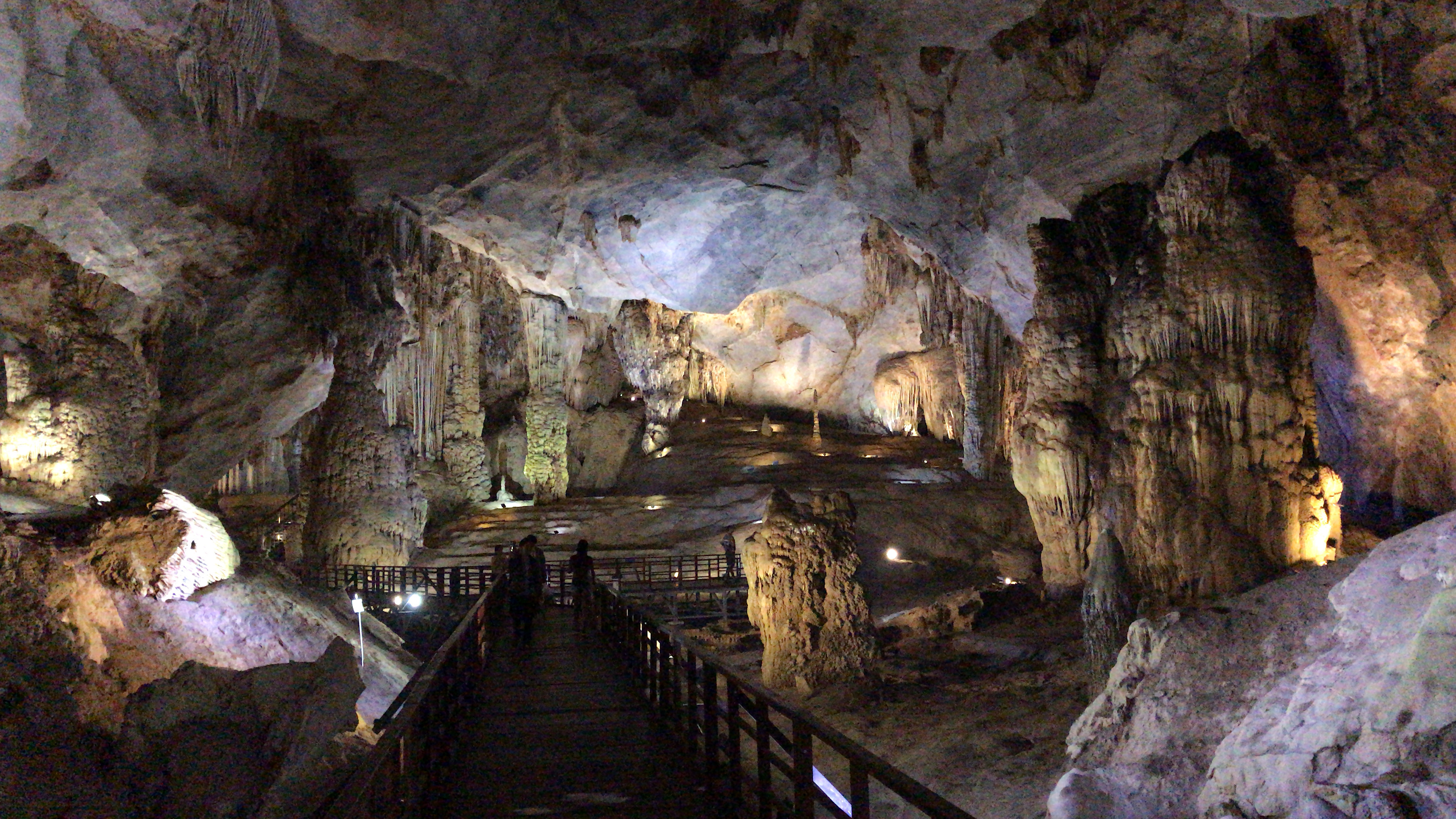
Paradise cave is a tourist-friendly cave to see. It is 31 km long, but you can visit just the first kilometer. It is huge. You walk though a tunnel which is 70m wide and 80m heigh. Colorful and shiny stalactites and stalagmites are illuminated by the lights on the wooden platform on which you walk. 10$ entrance, very expensive from Vietnamese standards: thanks to tourism, these caves are realy gold-mines for the local economy and people.
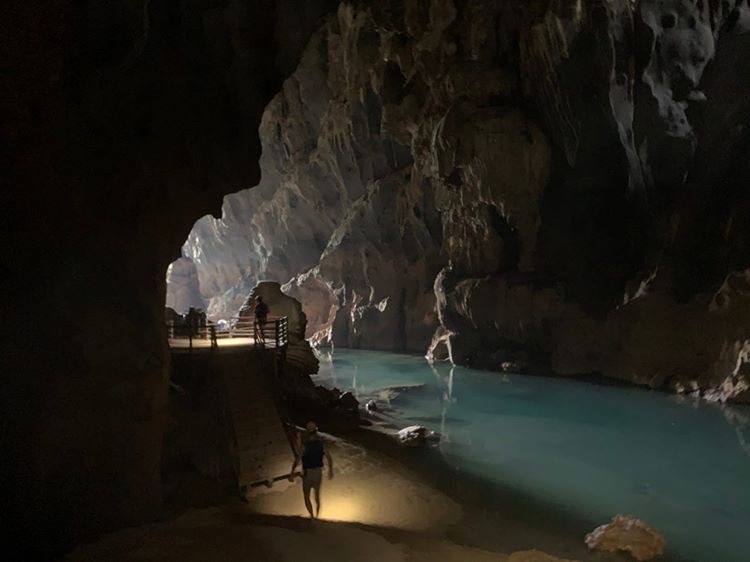
The Dark Cave is more adventurous. It must be visited with the guide (18$). You have to get a zip-line (carrucola), and swim in the river to get inside it (nothing difficult). Once inside, there are no lights, so you use the one on the helment (helmet is very important! At some point I bumped my head on a stalagmite that I did not see and it would have been very painful without helmet). You can swim on the blue lake inside, make a bath on a puddle of mud. If you are lucky (or unlucky, depends on the pov) you can see bats, snakes or even crocodiles.
If you have a duck livestock and you want to multiply you business profitability and volumes, why don't turn you farm into a Duck Stop? These guys organized a strage activity for tourists which is quite unique. They set-up an interactive show using their (more or less) 300 ducks. I am amazed how these animales do not stop eating whatever you give them. If you are animal sensitive / vegan maybe this place is not for you. I hope you will not judge me if I found it brilliant and very fun. Get a handful of seeds in your hand and let the ducks massage your palm. Or through some seeds on your barefeet, and let them give you the best foot-massage via beak. Not so igenic, very coronavirus-oriented, but YOLO right?
HA LONG BAY
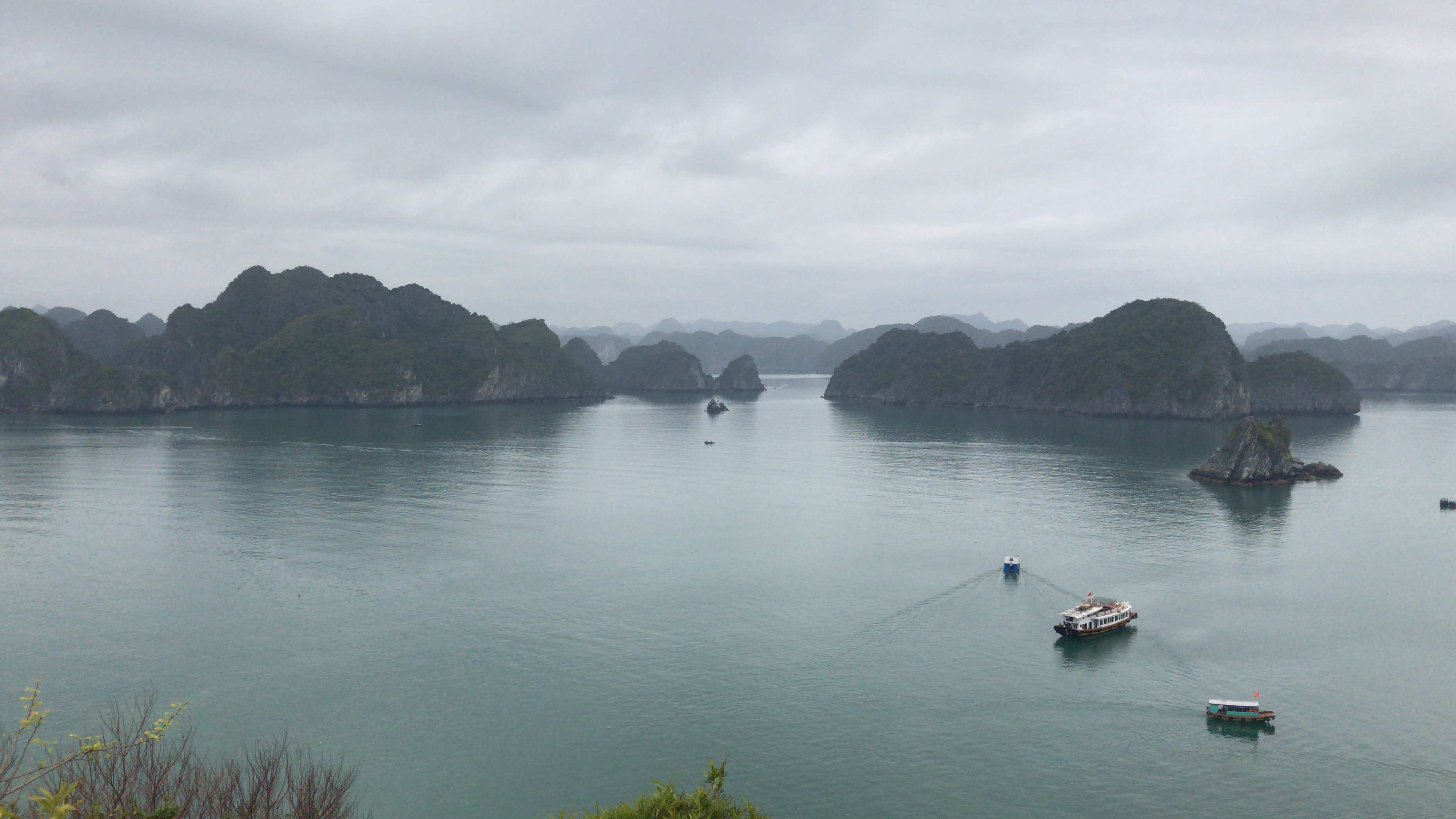
Unesco World Hertiage from 1994, and most visited aera of North Vietnam by travellers, Halong Bay is an archipelago of thousands of little calcareous-rock island on the East sea. It is a wonderful place to explore by daily boat trips organized by the countless travel agencies in whole North Vietnam. The weather was not so nice during my staying. With a clear sky you can appreciate the emerald water sourrounding the high rocks (called Karts) arising from the sea, resembling the landscape in South Thailand. But the little fog gave a sence of mistery and peace. You can do a daily organized trip, or 1-2 nights long journeys sleeping in luxurious boats or bungalows in private islands. Good idea for a honeymoon. I was actually staying in Cat Ba, which is close to Halong but less crowded.
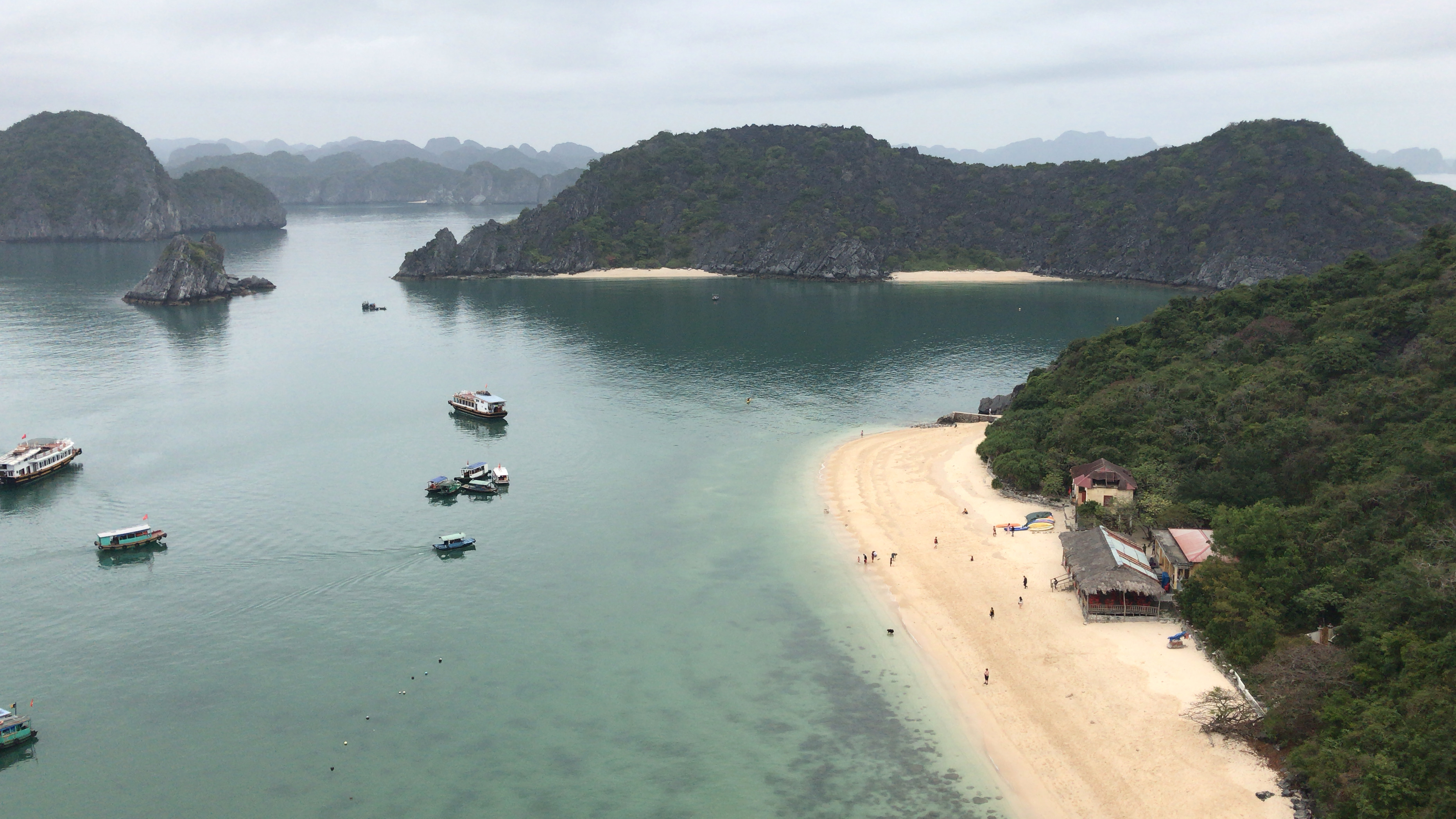
So just chose one of the thousands islands around and land with the boat to enjoy the immaculated white sand beaches. Go inside the karstic caves digged by the water and wind, and you can find yourself on the other side of the island. Here is a shot from the top of Monkey Island, after an half an hour free climbing on limestone rocks up to the top. The view was impressive and stunning. Monkey Island is populated guess by whom: monkeys. You can find them around or they can run toward you on the beach looking for food. Do not stare them directly in the eyes or show your teeth, otherwise they could freak out and come to beat you.
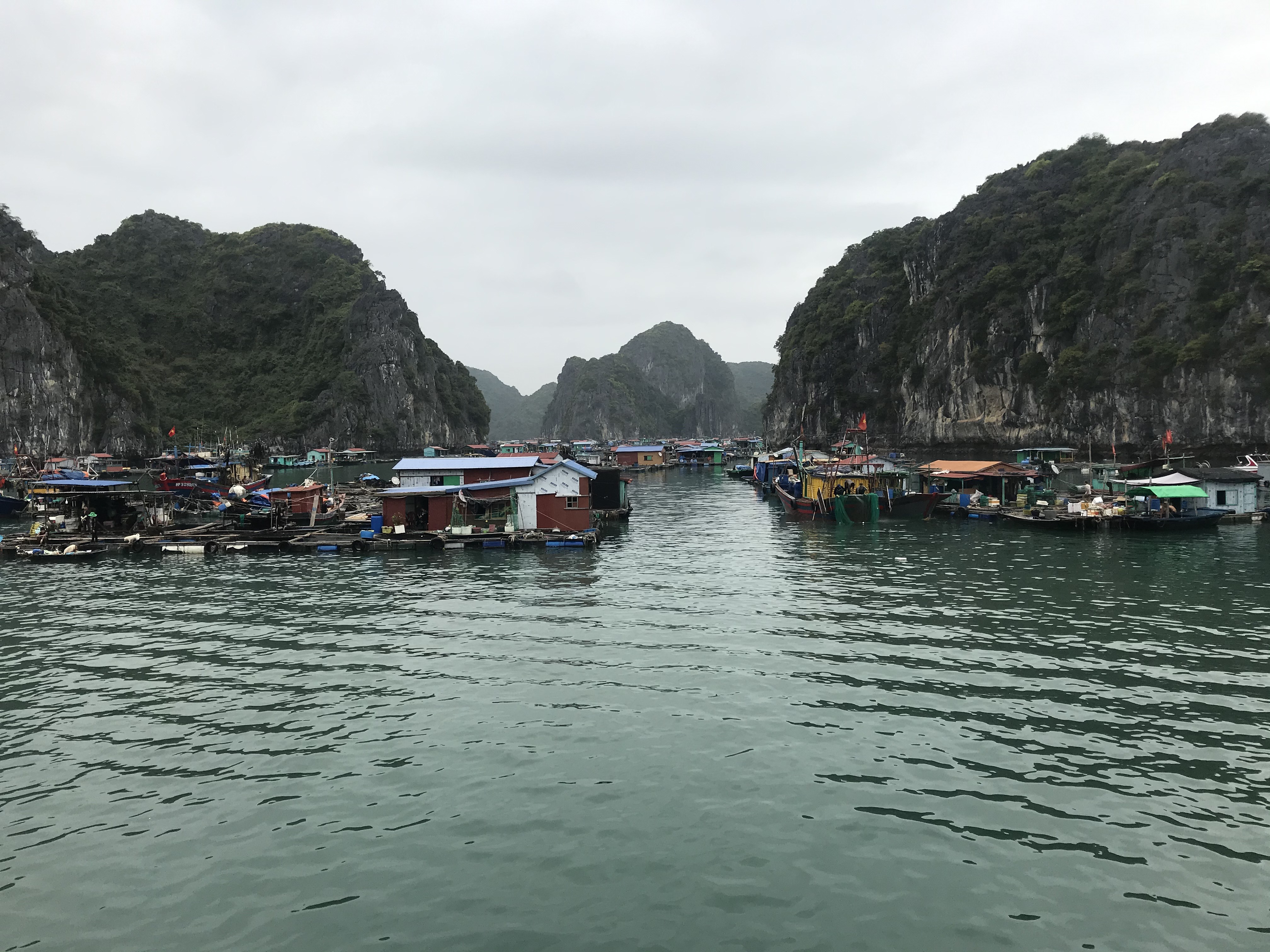
There are many floating villages along the way where small communities of fishermen make a living by breedig fish. There are even schools and police stations in these almost self-sufficient villages. The little houses are built with very cheap material, since they already take into account they may be destroied by the annual monsoons during rainy season. Is very nice to see these colorful little houses dumped on the water.
HANOI
Hanoi, 7.6 million people, is the second most populated city in VN after Saigon. It was the capital of Indochina (Laos + Cambodia + Vietnam) during the French occupation, the capital of North during the Vietnam War, and is the capital of modern Vietnam nowadays. It is a very colorful and full of green city, despite the pollution is very high. French architecture blends with communists majestic buildings. It is the most beautiful and peculiar big metropolis I saw in my trip.
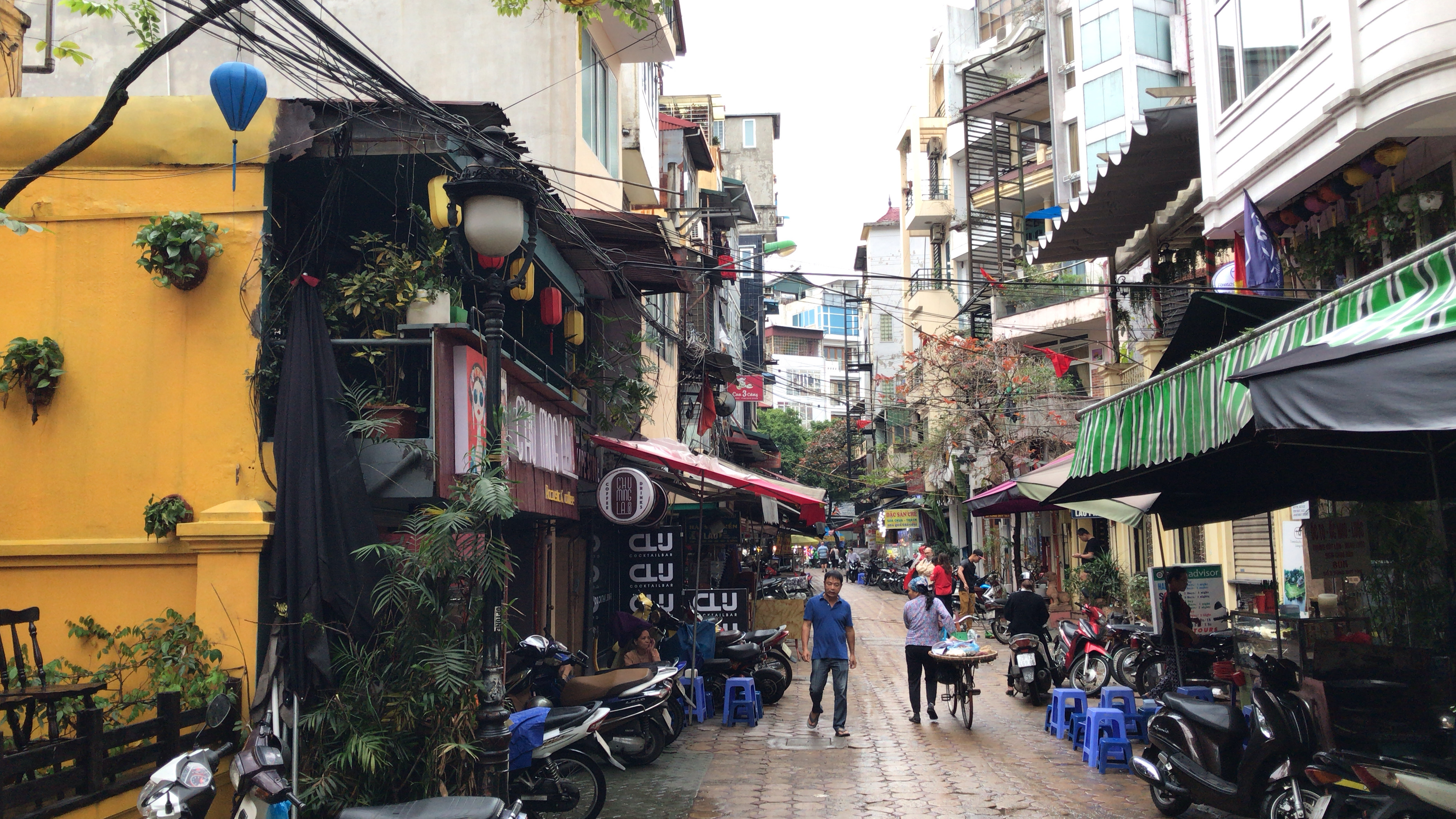
The old town is the center of sightseeing of Hanoi. It is a labirinth of narrow streets, with the sidewalk occupied my trees, food stalls and parked scooter, so you need to walk of the road dodging the motorbikes. Traffic is very challenging as everywhere is VN. Food is everywhere, bars propose the tyical "egg coffee", which is very very good (tastes of Tiramisu'), hawkers sells every kind of vegetables and fruits carring big baskets on bicicles. Many people from poor region of the countryside come to Hanoi to earn some money to send home. The told town is very vibrant both in the day and in the night, when bars become busy and you can enjoy the tipical beer Bia Hoi sold in the corners of the street. Houses are very tiny and high since many people wants to come here, and are very colorful. Pretty.
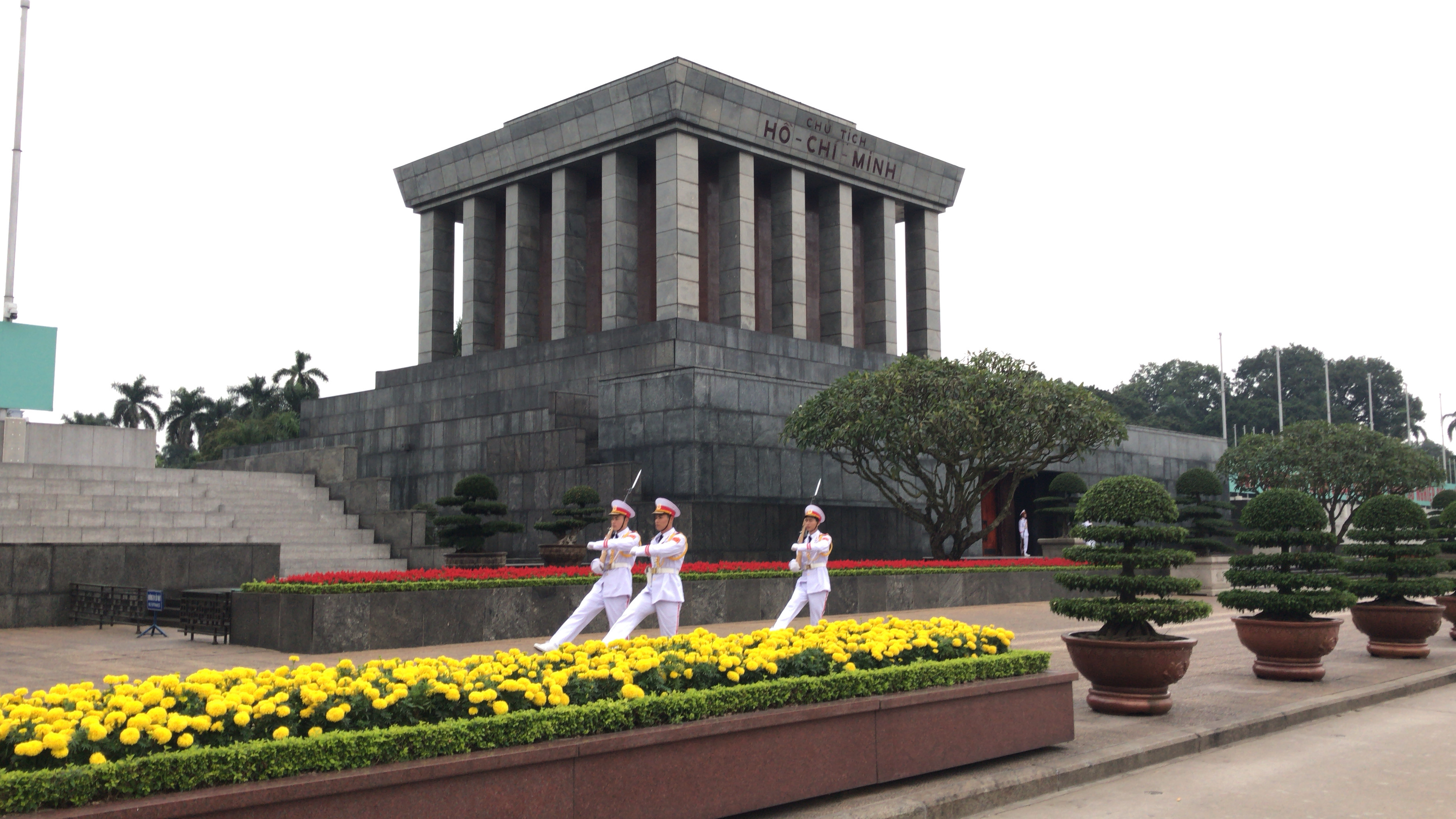
After seeing Mao in Beijing, I wanted to continue the tradition of see how the communist leaders of the past are doing. The Vietnamese leader is displayed in a glass tank inside this marble giant mausoleum in Plaza Ba Dinh (the equivalent of Tienanmen square in Beijing). Needless to say you cannot take picture of the old leader. I should say Uncle Ho (Bac Ho) is doing well, it still look as a nice old man. 3 months a year the corpse is sent to Russia for maineinance (probably the most expensive make-up process in the world is reserved to this communist leader, who would have thought that...). Many people every day come on pilgrimage to celebrate the beloved leader. Looking forward to see Lenin in Moscow.

One of the most iconic places in Hanoi is the Train Street in the heart of the city. The train rails run along this narrow street where many cafes and houses offer the typical kid-size tables and chairs to drink a smoothy or a coffee. In every street food place in Hanoi and Vietnam in general you get a sit in very tiny and short table with the little plastic chair little girls children use when playing with toy-kitchens. It is quite uncomfortable stay sit with your leg wide open to get close to the edge of the table, but it is a fun experience. The train does not pass through anymore since hoards of tourists on both side of the street used to make selfies while the train was coming, so authorities deemed it to be too dangerous.
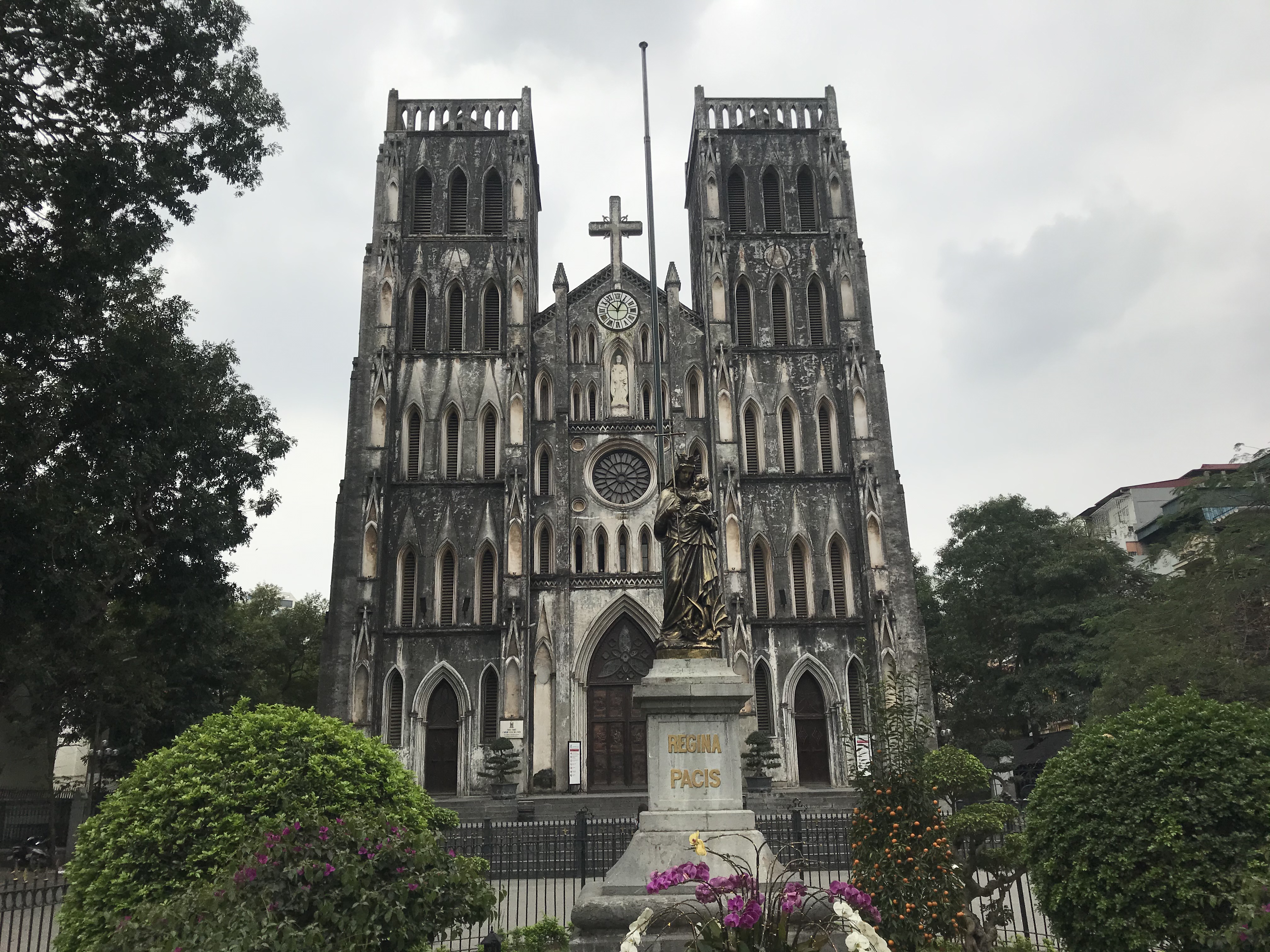
Saint Joseph Catedral, Neogothic-style church built in 1886 by the French people, is a Notre Dame in the far East (much more similar to the Pairs one than the Notre-Dame in Saigon). You get a sense of the pollution in the city by looking at it. I asked why they do not clean it: besides budget issues (even in Hanoi, as in Saigon, there are struggling to find money for building the subway), Hanoi people are actually attached to their black catedral. And I agree with them. The black shades culumated during the years catches your attention. I love when walking around messed-up, dirty, poor alleys typical of Asia you suddenly end up in wide squares with majestic Euopean bulings. It is something that can only happen in Asia.
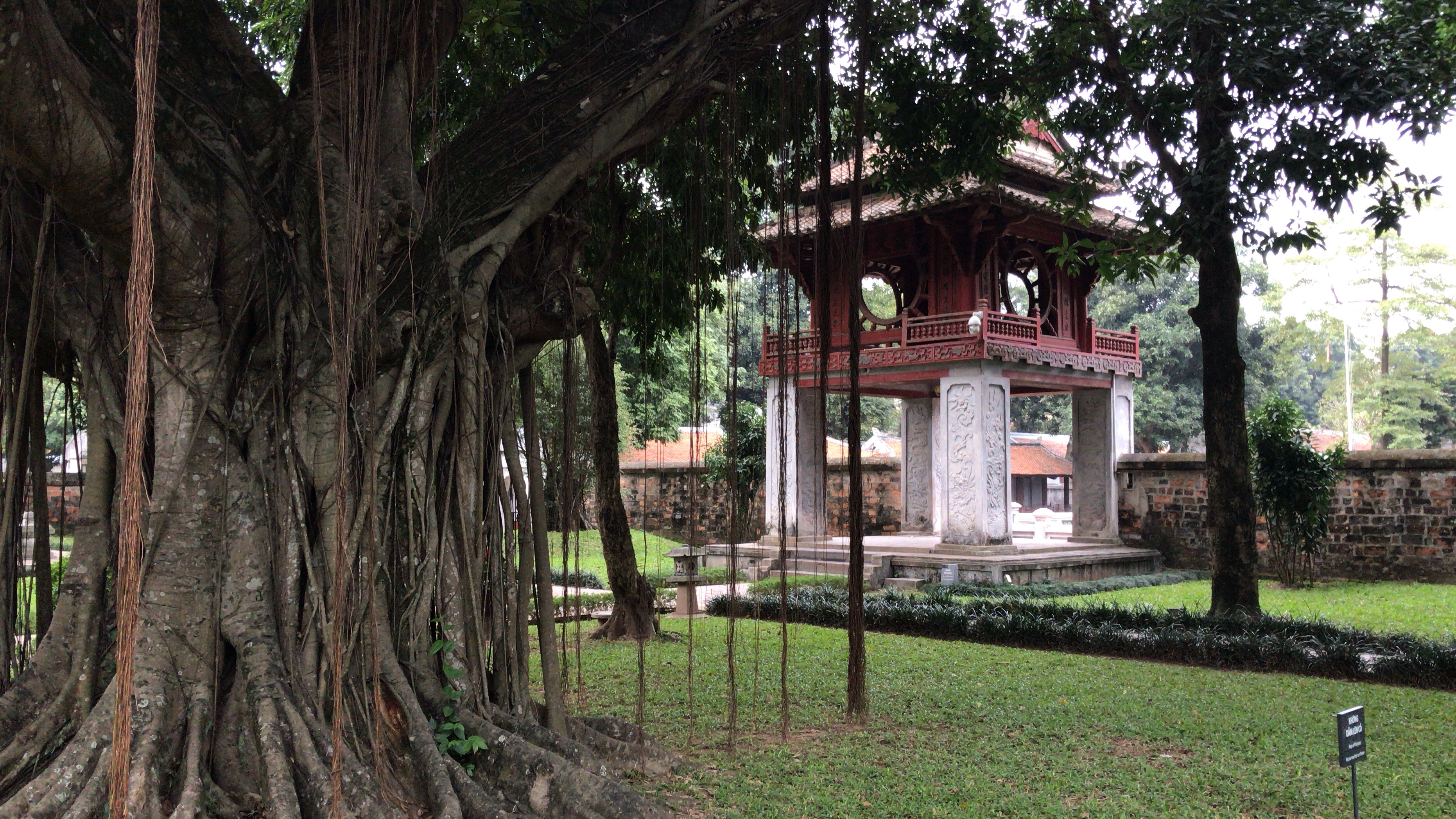
A pieceful chunk of land in the center of the city, the Temple of Literautre was the first university in Vietnam back in 1076. Every day students come to pray for good grades.
Random facts about VN: I found them very similar to Chinese: they love Karaoke (when you go around remote villages in the countryside you happen to hear loud music and people singing inside houses in the afternoon), honking horns are continuos in the streets; they spit on the ground and make strange noises. They are sweet souls, even if many tries to screw you in many was possible (like everywhere in the world when it comes to tourism relationship). Internet is very bad in Vietnam. 2 plates of noodles costs like 1 night accomodation in a splendid hostel.

Simbol of the tenaciousness of Hanoi population, the Long Bien brigde was frequently destoyed by American bombing during the war. It was the most important infrastucture of the city: a huge iron bridge, designed by Gustave Eiffel, crossing the Red River. Each time the bridge got destroyed, the Vietnamese rapidly fixed it after watching it being destroyed again and again. Today you can cross the bridge with a 40 minutes walk. The river beneath is covered by plants and floating houses, so you do not really see the water. I was freaking out while walking the bridge on the pedestrian way since you just step on a series of thin stone pads. If one of them happen to break, you would fly for 30 meters. Maybe I was too exagereted, since there are hundred of thousands of people corssing it every day, but I came back after 10 minutes walk.
My Vietnam Soundtrack:
- Shotgun - George Ezra
- Shotgun - Us The Duo
- Lorde 2pac Beck Mashup - Pomplamoose
- Sweet but Psycho - Ava Max
- C'era un ragazzo - Morandi, Baglioni
- Good Girls - LANY
- Misread - Kings of Convenience
- Sweet Boy - Sophia Viggiano
- Baby Let's Go - Fruition
- Bulletproof - La Roux
- Into Yellow BOA Remix - Martin Luke Brown
The Riunification Palace, former Independence Palace, was the headquarter of the government of South Vietnam, suppored by USA in the fight against the expansion of communism in Asia. The war operations and intelligence were conducted in the bunkers underground the palace, which are very interesting to visit. It was also the residence of top-officials Saigon government. There are many big cerimonial halls used to host international diplomats and officials, especially from America, Austalia, New Zeland, the "Western" countries partecipating in the war. It is a very nice and massive '60s style architecture palace in Saigon. In 1975, the tanks of the Nord-Vietnam NLF (National Liberation Front aka Viet Cong, VC) braking the fence simbolized the end of the war, the victory of the communists and the unification of a independent Vietnam. Saigon became HCMC.